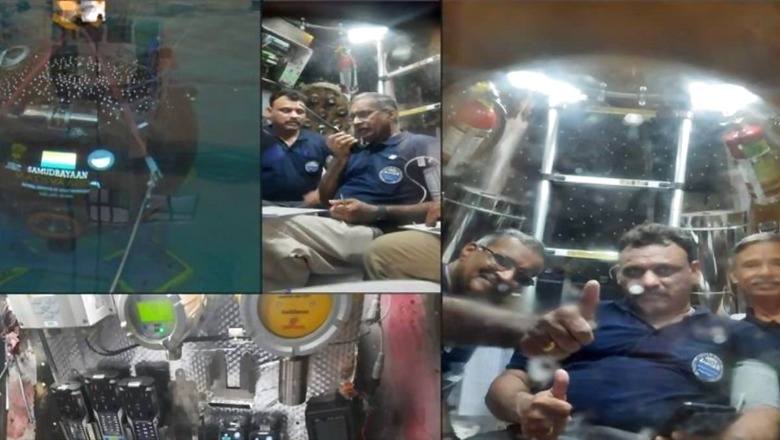
views
India’s oceanographers are gearing up to undertake their biggest-ever expedition into the Indian Ocean yet. Almost a year from now, the team will ready the country’s first prototype of the manned submersible to dive into the ocean to a depth of about 500 metres and return to the surface.
“The actual target is 6,000 metres — the deepest point of the Indian Ocean. But before we attempt that, we have to demonstrate that we can safely go at least 500 meters beneath the sea. We are planning to do the first trial run by March 2024. A sphere-shaped capsule made of steel has been readied,” M Ravichandran, Secretary to the Ministry of Earth Sciences, told News18 in an exclusive interview. The capsule has also undergone under-water testing in Bay of Bengal.
India’s oceanographers are gearing up to undertake their biggest-ever expedition into #IndianOcean to build country's first manned submersible which will take three persons 6,000 metres deep in water M Ravichandran, Secretary to Ministry of Earth Sciences, speaks to @Srish__T pic.twitter.com/9gMVE28Y5N
— News18 (@CNNnews18) March 27, 2023
Scientists are eyeing a late 2025-26 launch for the final expedition which requires a manned submersible made up of Titanium alloy. Unlike steel, Titanium can withstand the increasing pressure at the bottom of the sea. The sphere will accommodate three persons armed with a suite of scientific sensors and tools to collect data and observations.
If India succeeds, it will become the sixth nation in the world to achieve the feat. Only five countries have successfully demonstrated the capability for deep-sea missions so far — Russia, France, Japan, China and the United States — he added.
India’s First Manned Submersible
“It is almost like a human spacecraft but under the sea,” says the top official, elucidating several challenges that scientists from over six institutes — including ISRO — are currently taking on to build India’s first-manned submersible. Unlike a submarine that can only go up to 300 metres, it will travel 6,000 metres deep.

“The toughest task is to ensure the sphere withstands the high pressure in the sea. It also requires a life support system for the crew to breathe. Then, it also has to go down and come up when required. If its weight exceeds even one gram from what’s required, it will not come up. So all measurements have to be very precise,” he said, adding that the various crucial components are currently under development.
This includes underwater acoustic communications and emergency rescue systems which are critical before it goes for a final review and certification under global rules.
The manned submersible is currently being designed at Chennai’s National Institute of Ocean Technology (NIOT) in association with a team from Vikram Sarabhai Space Centre (VSSC). With a diameter of about 2.1 meter, the Titanium Alloy Personnel Sphere can endure up to 12 hours under normal operation and 96 hours in case of emergency for human safety. Planned at an overall cost of Rs. 4,077 crore for a period of five years starting 2021-22, the Deep Ocean Mission is already in its first phase.
Mining Precious Metals
India’s ambition to send its scientists into the deepest point of the Indian Ocean is driven by its plan to explore and mine over 300 MMT of valuable deposits of metals like copper, zinc, aluminium, and platinum hidden under the sea. The expedition will be a starting point for many autonomous and robotic underwater missions (AUVs and RUVs) in the near-future, equipped with an integrated mining system.
“We have taken the permission to explore this area from the International Seabed Authority on a contract-basis. We have roughly inferred around 12 such test-mine sites in the mid-ocean ridge. Now we have to hunt these locations and estimate their resource potential. Each year, we want to identify 2-3 such vents. This year, we couldn’t get the ship. Hopefully, by this time next year, we would identify 4-5 such sites out of total 12,” said the top official.

India also plans to ready a state-of-the-art research vessel for deep ocean exploration under the Samudrayaan Project. “We will use the ship for all deep sea exploration. The tender process is currently on,” he added. The scientists also plan to use a remotely operable underwater vehicle to go into the sea area and collect data about the marine species available in country’s zone. The biodiversity mapping is crucial as part of the global commitment to save 30 per cent of oceans by 2030.
Bracing For Climate Change
With the sea levels rising by about 3mm globally, the threat of extreme weather events along the coastal areas has also increased. A crucial part of the Deep Ocean Mission is also to collect observations to study how the Indian sea coast is changing, and make accurate future projections of cyclones and storm water surges to safeguard coastal populations, said the top scientist.
“Climate change is happening. There is no way we can escape it. But it is our duty to mitigate and adapt, and for that we need to urgently amp up our forecasting capabilities. We want to deploy more instruments at least 2 km beneath the sea surface to strengthen our climate advisory services,” he added. “Our focus is on improving our prediction in all time-scale. Next week, next month, next year and next decade, and a lot of those answers are hidden in the seas.”
Read all the Latest India News here

















Comments
0 comment